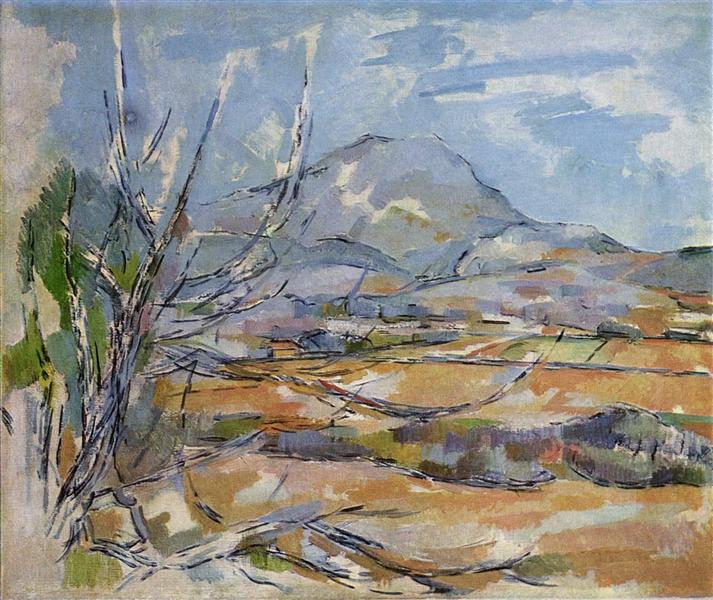Descrizione
L'opera "Mont Sainte-Victoire" di Paul Cézanne, dipinta nel 1890, è eretta come pietra miliare nella storia dell'arte, incapsulando l'essenza della transizione tra impressionismo e arte moderna del ventesimo secolo. In questa famosa rappresentazione del monte provenzale che ha ispirato il maestre Durante la sua carriera, Cézanne non solo cattura la forma e il colore del paesaggio, ma sfida le convenzioni pittoriche del suo tempo, offrendo un approccio non pubblicato che riconfigura per sempre il modo di vedere e comprendere la natura.
Osservando la composizione, l'uso di forme geometriche che Cézanne usa per strutturare il paesaggio è notevole. La montagna, che si trova sullo sfondo, è presentata quasi come un oggetto cubico, con le sue linee saldamente, rompendo così la morbidezza tipica dei paesaggi impressionisti. Questo approccio distintivo è uno dei francobolli caratteristici di Cézanne, in cui le forme diventano la base della percezione visiva. Le pennellate, dense e visibili, rivelano il loro intenzionale processo di pittura, creando una consistenza che sembra vibrare con la luce.
Il colore svolge un ruolo fondamentale nel lavoro. Cézanne usa una tavolozza che riflette la luminosità del paesaggio mediterraneo, chiarire il verde e il blu con ocra e giallo che danno calore alla scena. Questi colori, applicati a strati, configurano un'atmosfera ricca e vibrante, in cui l'impatto della luce sulla superficie del paesaggio diventa quasi palpabile. È un trattamento a colori che prefigura molti dei principi essenziali del fauvismo e del cubismo, stili che si sviluppano fortemente nei decenni successivi.
In vista ci sono vaghi colpi di vegetazione in primo piano, che sono spesso interpretati come simboli della splendida natura della regione provenzale. Tuttavia, contrariamente alla grandiosità della montagna, la flora sembra quasi insignificante e subordinata, una scelta deliberata da parte dell'artista che mette in evidenza la monumentalità del Mont Sainte-Victoire. L'assenza di personaggi umani nel dipinto intensifica questa sensazione di grandezza naturale, concentrando tutta l'attenzione sugli elementi del paesaggio.
Cézanne, per tutta la sua carriera, si è sentita fortemente connessa a questa montagna, che non solo rappresentava un luogo fisico, ma anche una fonte inesauribile di ispirazione emotiva ed estetica. Il "Mont Sainte-Victoire" appare in numerose versioni e variazioni, ognuno esplora angoli e sensibilità diverse dello stesso tema, che mostra il suo continuo fascino da parte di questo paesaggio emblematico.
Questo quadro è riconoscibile non solo per la sua unicità, ma anche per la sua capacità di influenzare le successive generazioni di artisti. Cézanne è stabilito come precursore della modernità artistica, avvicinandosi alla tela con un rispetto per la forma e la struttura che costringerà le generazioni di pittori a riconsiderare il proprio rapporto con la natura e la rappresentazione pittorica.
In breve, "Mont Sainte-Victoire" del 1890 non è solo una rappresentazione di un paesaggio, ma un'affermazione della visione unica del suo creatore. Attraverso la sua intelligenza compositiva, il suo audace trattamento del colore e la sua interpretazione della luce, Cézanne ci invita a riscoprire il mondo naturale con una nuova prospettiva, che continua a risuonare nell'arte contemporanea. La montagna diventa così un simbolo sia sempre sempreverde che di ingegnosità umana, una testimonianza duratura della profonda connessione tra l'artista e i suoi dintorni.
KUADROS ©, una famosa vernice sul muro.
Dipinti ad olio fatti a mano, con la qualità degli artisti professionisti e il distintivo sigillo di KUADROS ©.
Servizio di riproduzione delle immagini con garanzia di soddisfazione. Se non sei completamente soddisfatto della replica del tuo dipinto, rimborsiamo i tuoi soldi al 100%.

